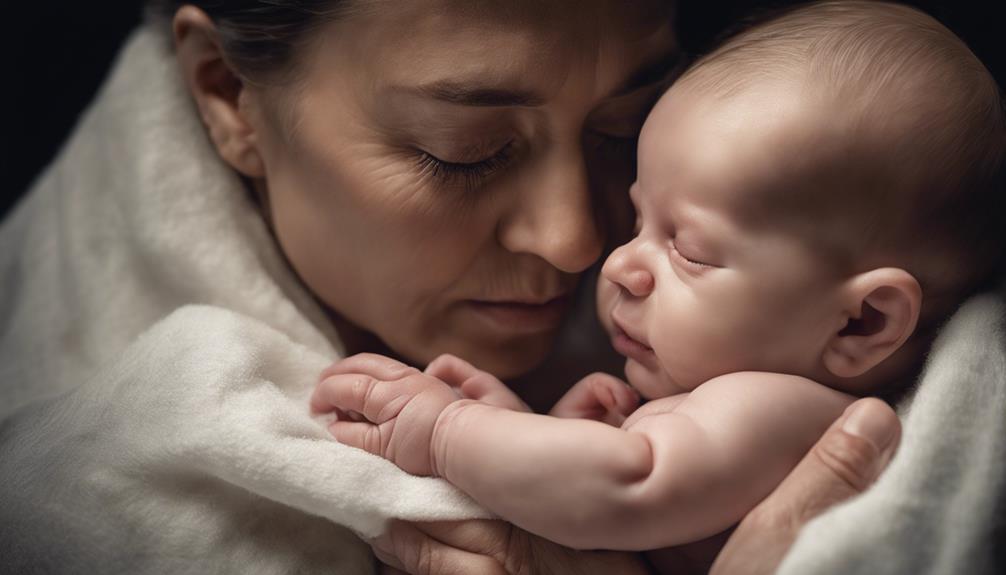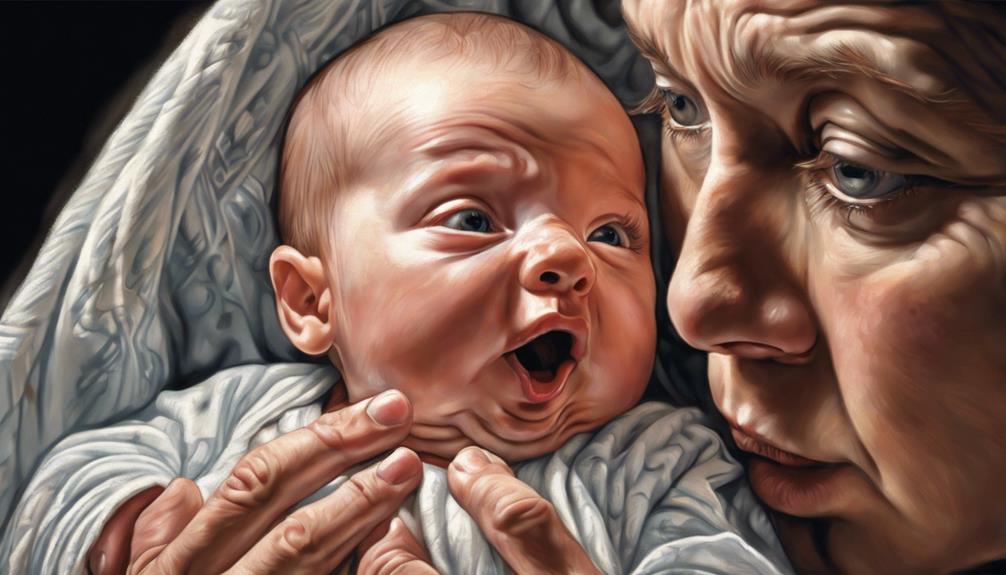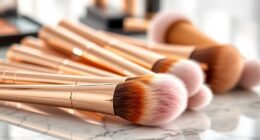To care for your baby’s umbilical cord, keep it clean and dry by gently wiping with a damp cloth or antiseptic as advised, and avoid submerging your baby during baths—opt for sponge baths instead. Change diapers frequently, fold the diaper below the cord to expose it to air, and avoid covering it with tight clothing. Watch for signs of infection like redness or foul odor. Following these steps promotes healthy healing; learn more to make certain you’re doing everything right.
Key Takeaways
- Keep the umbilical cord dry and exposed to air; avoid covering with diapers or clothing.
- Gently clean the area daily with a damp cloth or recommended antiseptic.
- Change diapers frequently to prevent moisture buildup and keep the cord dry.
- Watch for signs of infection such as redness, swelling, foul odor, or pus.
- Avoid pulling or tugging on the cord; seek medical advice if symptoms of infection appear.
Understanding the Basics of Umbilical Cord Care

Understanding how to care for your baby’s umbilical cord is essential to prevent infection and promote healing. The umbilical cord contains cord blood, which is crucial for your baby’s blood supply before birth. Proper umbilical hygiene involves keeping the cord dry and clean to ward off germs. You don’t need to use alcohol or wipes unless your healthcare provider advises it. Instead, simply keep the area exposed to air and avoid covering it with tight clothing or diapers. Watch for signs of infection, such as redness, swelling, or foul odor. Remember, every baby heals at their own pace, so gentle care and careful observation help ensure a healthy, infection-free recovery. Proper umbilical cord care sets the foundation for your baby’s overall health. Additionally, understanding AI integration in healthcare devices is shaping innovative approaches to monitor and support neonatal health. For example, some modern devices now incorporate electric power generation techniques to improve monitoring capabilities in remote or resource-limited settings.
Preparing for Cord Care: Supplies and Environment
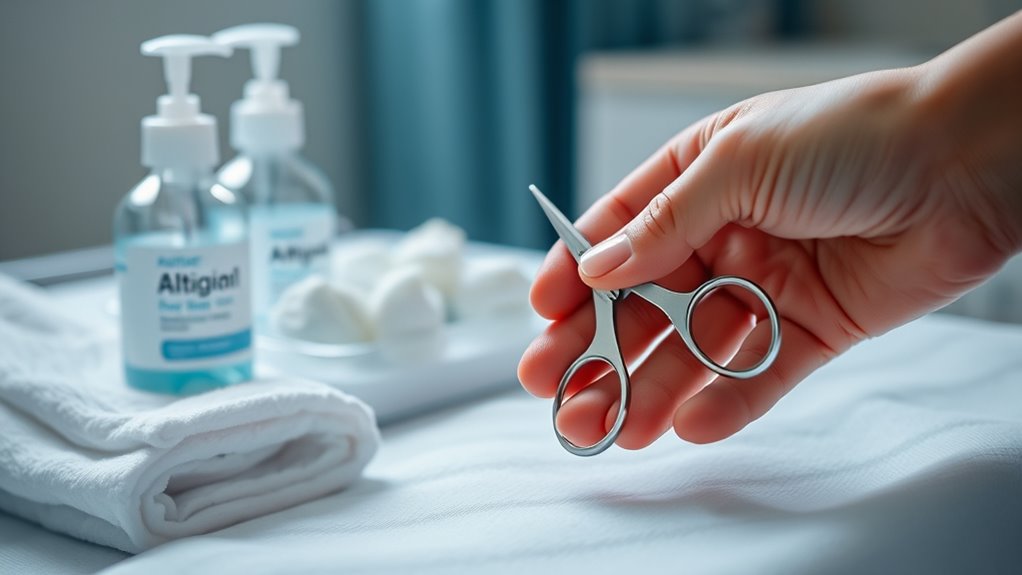
Getting ready for your baby’s umbilical cord care starts with gathering the right supplies and creating a suitable environment. Confirm you have sterile gloves, alcohol wipes or antiseptic solution, and soft cotton swabs. Keep a clean, dry cloth nearby for cord drying. Choose a warm, well-ventilated space to minimize infection risk. Proper diaper positioning is essential; fold the diaper below the cord to keep it exposed and dry. Use the following table to clarify:
| Supplies | Environment Tips |
|---|---|
| Sterile gloves | Keep the area warm and draft-free |
| Alcohol wipes/antiseptic | Ensure good ventilation |
| Cotton swabs | Avoid covering the cord with the diaper |
This setup promotes healing and prevents infection. Additionally, ensuring the environment adheres to infection prevention guidelines helps reduce the risk of complications. It is also helpful to maintain a clean environment to support the healing process.
Daily Care Routine for Your Baby’s Umbilical Stump
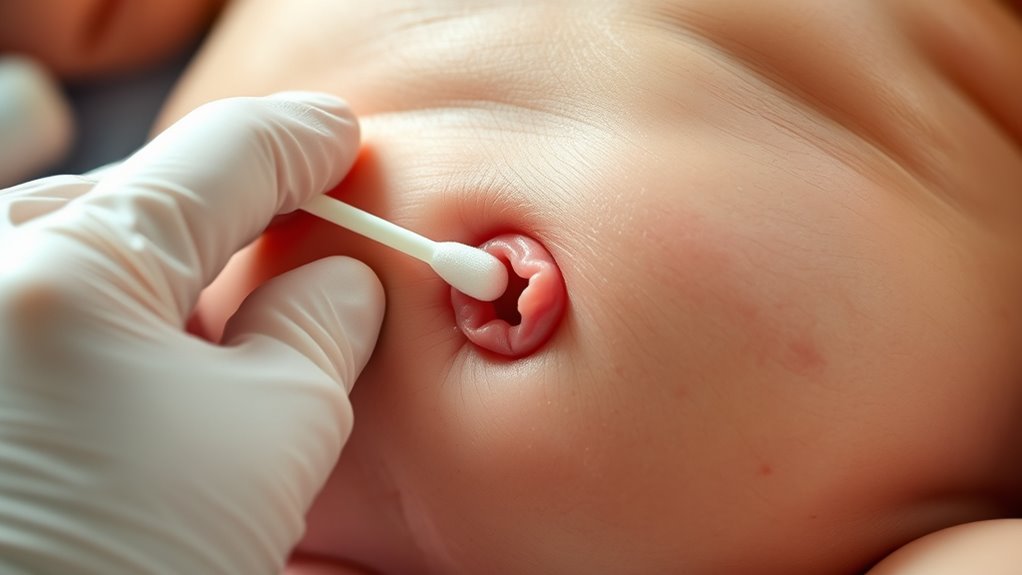
To keep your baby’s umbilical stump healthy and promote healing, you should clean and dry it during your daily care routine. Good cord hygiene involves gently wiping the area with a clean, damp cloth or alcohol swab if recommended by your healthcare provider. During bathing routines, avoid submerging the stump in water; instead, give your baby sponge baths until the cord falls off. Keep the area dry and exposed to air as much as possible to prevent moisture buildup. Change your baby’s diaper frequently, ensuring that it doesn’t cover the stump. Always handle the cord with clean hands, and avoid pulling or tugging. Proper air circulation around the umbilical area can also help speed up healing and reduce the risk of infection. Maintaining a clean environment is essential for preventing bacteria from causing infection or delay healing. Consistent, gentle care helps prevent infection and encourages proper healing of the umbilical stump.
Signs of Infection and When to Seek Medical Advice
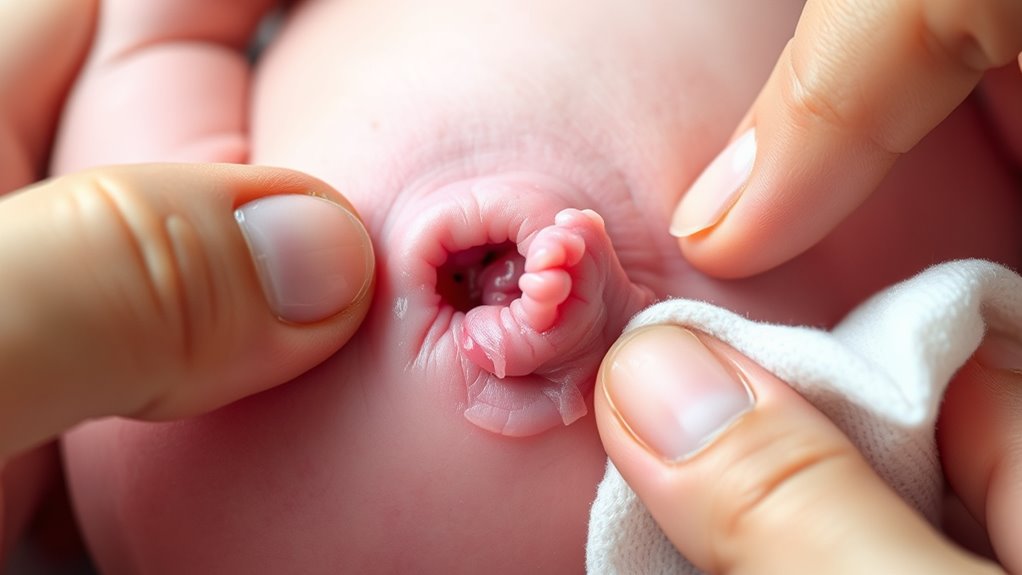
While maintaining a daily care routine helps promote your baby’s umbilical stump’s healing, it’s equally important to recognize signs that may indicate a cord infection. Look for redness, swelling, or warmth around the base of the stump, which could signal an infection. Any foul odor, pus, or discharge is a clear warning sign. Also, monitor your baby for fever, fussiness, or difficulty feeding, as these may suggest a more serious issue. If you notice any of these symptoms, don’t hesitate to seek medical consultation promptly. Early intervention can prevent complications and ensure your baby’s health. Additionally, being aware of proper hygiene practices can significantly reduce the risk of infection. Using gentle cleansing methods and appropriate products can help keep the area clean and dry. Trust your instincts—when in doubt, consult your healthcare provider to ensure proper care and peace of mind. Dri Dri Gelato
Tips for Promoting Healthy Healing and Cord Detachment

Promoting healthy healing and ensuring your baby’s umbilical cord detaches naturally involves simple, consistent care practices. To support ideal cord healing and prevent infection, keep the area clean and dry. Avoid pulling or tugging on the cord, and stick to gentle cleaning with water if needed. Use a clean, dry cloth for diaper changes, ensuring urine and stool don’t irritate the stump. Expose the cord to air whenever possible to speed drying. Watch for signs of infection, like redness or swelling, and seek medical advice if you notice any issues.
Keep your baby’s umbilical cord clean, dry, and exposed to air to promote healing and prevent infection.
- Gently clean the cord with water, never harsh chemicals
- Keep the area dry and exposed to air
- Change diapers frequently to prevent moisture build-up
- Avoid covering the cord with tight or plastic clothing
- Stay alert for signs of infection and act quickly
Frequently Asked Questions
How Long Does It Typically Take for the Umbilical Cord to Fall Off?
The umbilical cord usually falls off within 1 to 3 weeks after birth. During this cord separation process, you might notice some redness or oozing, but that’s normal as the area heals. Keep the area clean and dry to support the healing timeline. If the cord doesn’t fall off after three weeks or shows signs of infection, consult your pediatrician to ensure proper healing and care.
Can I Bathe My Baby Before the Cord Falls Off?
Yes, you can bathe your baby before the cord falls off, but you should avoid submerging the cord in water. Instead, opt for sponge baths to keep the cord dry and promote proper cord hygiene. This approach helps prevent infection and keeps your baby’s bathing routine safe and comfortable. Just be gentle around the cord area and make sure it stays dry until it naturally falls off.
Is It Safe to Use Alcohol or Antiseptic Solutions on the Cord?
You should avoid using alcohol or antiseptic solutions on your baby’s cord unless your healthcare provider recommends it. Let the cord dry naturally, which promotes healing. Using antiseptics can sometimes delay drying and increase irritation. Keep the area clean and dry, gently fold back the diaper if needed, and allow the cord to fall off naturally. If you notice any signs of infection, contact your pediatrician immediately.
What Should I Do if the Cord Stump Has a Foul Smell?
If your baby’s cord stump has a foul smell, it could be a sign of a cord infection. For example, a parent noticed a strong odor and redness around the stump, prompting a visit to the doctor. You should keep the area clean, avoid covering it, and seek medical attention promptly. A healthcare professional can evaluate for infection and recommend appropriate treatment to prevent complications.
Are There Any Activities to Avoid During Cord Healing?
During cord healing, avoid activities like cord tugging, which can cause bleeding or delay healing. Also, keep the diaper covering the stump loose to prevent irritation and moisture buildup. Don’t pull or tug on the cord, and steer clear of submerging the baby in water until the cord falls off and heals completely. These precautions help reduce infection risk and support smooth healing.
Conclusion
Taking good care of your baby’s umbilical cord ensures a smooth, gentle journey toward healing. With patience and attention, you’re guiding this tiny miracle through a delicate chapter, helping it blossom into a healthy, happy belly button. Trust your instincts and keep a watchful eye—soon, this small milestone will become a sweet memory, leading your little one toward their next adventure. Every gentle step you take nurtures their precious beginning.





